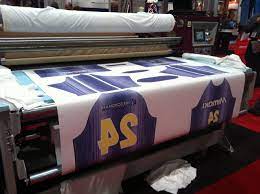Part 1: What is a Sublimation Paper?
Sublimation paper printing has become widely popular for transferring designs into your choice of material.
But what is sublimation paper?
Well, a Sublimation paper plays a crucial role in the sublimation printing process. As said above, it helps you transfer images or designs onto materials by applying heat and pressure. This technical paper comes coated with heat-sensitive ink that builds into a gas when it comes into contact with high temperatures and, thus, permanently bonds with the material’s fiber.
These special papers are available in numerous sizes, weights, and thicknesses for easy usage and to cater to different printers and crafting needs. Hence, selecting the appropriate sublimation paper type is vital if you want to achieve high-quality prints and, in the process, avoid any potential harm to your equipment. So, it is better to include factors like printer compatibility, paperweight, thickness, ink drying time, and color vibrancy while picking one.
Most craft enthusiasts favor sublimation paper since it can easily personalize items like t-shirts, mugs, phone cases, and more. Its prints are vibrant, durable, and resistant to cracking, peeling, or fading over time. With proper techniques and tools, even a novice can elevate their crafting projects on sublimation paper, making it a growing in-house business.
Part 2: How to use a Sublimation paper?
How to use a sublimation paper the correct way?
Let us take the example of HTVRONT sublimation paper, an excellent choice for printer compatibility. Its size, measuring 13″ x 19″, makes it perfect for larger surfaces.
Compatibility:
HTVRONT sublimation paper works seamlessly with any inkjet printer, including the Sawgrass Virtuoso SG500. The print quality and transfer rate are impeccable with printers from other popular brands like HP, Canon, and Epson.
The HTVRONT sublimation ink provides optimal results, especially on light-colored fabrics such as bags, t-shirts, and pillows. This paper type is well-suited for less than 30% cotton content substrates. Moreover, HTVRONT sublimation paper can also be effective on coasters, mugs, phone cases, metal plates, and more.
Types:
While HTVRONT offers a range of sublimation paper variants, the 13″ x 19″ paper sheets are the ones that truly excel.
A pack of 120 sheets, each costs less than 30 cents. However, if you want smaller substrates like mugs or crop tops, you can opt for an 8.5″ x 11″ pack of 120 sheets, costing $0.13.
All sizes of HTVRONT sublimation paper exhibit minimal to zero bleeding, saving you up to 20% annually. Its uniform 125 GSM basis weight also allows it to perform well with substrates beyond fabric.
Usage:
The HTVRONT sublimation paper works with a wide range of sublimation blanks, with the recommended temperature range varying depending on the material.
- A suggested temperature range of 280-350 degrees Fahrenheit is suitable for standard ceramic mugs.
- For textiles with cotton content lower than 30%, it is advisable to increase the temperature range to 356-392 degrees Fahrenheit.
- A range of 20 to 50 psi is recommended for pressure settings, offering optimal results.
- The duration under the heat press may vary between 0 to 4 minutes, depending on the specific substrate.
Technical Elements:
The HTVRONT sublimation paper boasts an excellent high transfer rate of 98%. Notably, the coating on this paper feels slightly thicker, reducing the likelihood of bleeding. It maintains optimal tackiness, and the ink drying rate is rapid, taking less than a minute. Moreover, this paper type saves ink and remains flat without curling, ensuring the best transfer quality.
Part 3: Dos and Don’ts with Sublimation Paper
Here are some dos and don’ts that we suggest with a sublimation paper:
Dos:
- Select the accurate sublimation paper via factors such as printer compatibility, paper weight and thickness, and desired print quality.
- Align and securely place the sublimation paper on the substrate before applying heat and pressure to prevent shifting or misalignment.
- Always use a compatible heat press or transfer equipment with accurate temperature and pressure controls. Follow the manufacturer’s instructions on the type of substrate and sublimation paper.
- Test the print and transfer on a sample or scrap material before proceeding with the final project. Evaluate the colors, image quality, and overall transfer result in advance.
- Handle the sublimation paper with clean and dry hands to avoid smudging or transferring oils or moisture onto the surface. Maintain the integrity of the ink and prevent unwanted marks on the final print.
- Keep the sublimation paper in a cool, dry corner, away from direct sunlight and excessive moisture, to preserve the quality and longevity of the paper.
Don’ts:
- Using the wrong printer with wrong sublimation paper can damage the printer and give you bad result.
- Do not touch the printed side of the sublimation paper with bare hands or allow it to come into contact with any moisture or liquids before the transfer.
- Each sheet is for single use only, so never reuse the same sheet.
- Allow the material to cool down completely before handling or applying additional finishing treatments, such as protective coatings or pressing for a longer-lasting result.
- Excessive heat or pressure during the transfer process can lead to smudging, distortion, or damage to the substrate or sublimation paper.
- Folding or creasing the sublimation paper can create uneven pressure during transfer and affect the overall image quality.
Follow these dos and don’ts to achieve optimal results with sublimation paper and bring forth prints that are vibrant, long-lasting, and of high quality.
Part 4: Summary
Thus, that was our brief insight into the sublimation paper, how to use it, and a few tips to get the optimum result.
Lastly, we would like to recommend the HTVRONT sublimation paper and printer for the best output for your designs and images.
So, we hope you can enjoy your creation printed on various materials for office and home usage. Keep it up!
